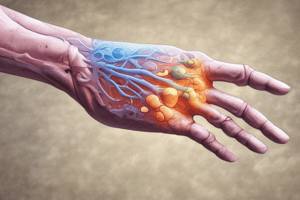Podcast
Questions and Answers
What term describes the predicted outcome of a disease?
What term describes the predicted outcome of a disease?
- Prognosis (correct)
- Symptomatology
- Pathology
- Diagnosis
Which of the following is considered a sign of a disease?
Which of the following is considered a sign of a disease?
- Nausea
- Fatigue
- Fever (correct)
- Pain
What is described as a small sample taken from the body to represent the nature of the whole?
What is described as a small sample taken from the body to represent the nature of the whole?
- Culture
- Biopsy
- Specimen (correct)
- Sample
Which diagnostic procedure involves visual examination using a tool?
Which diagnostic procedure involves visual examination using a tool?
Which imaging technique uses magnetic fields and radio waves to visualize internal structures?
Which imaging technique uses magnetic fields and radio waves to visualize internal structures?
What does 'palpation' refer to in basic examination procedures?
What does 'palpation' refer to in basic examination procedures?
Radiology is primarily concerned with which of the following?
Radiology is primarily concerned with which of the following?
Which of the following is NOT a common diagnostic test or procedure?
Which of the following is NOT a common diagnostic test or procedure?
A common examination procedure that measures respiratory rate is known as?
A common examination procedure that measures respiratory rate is known as?
Nuclear imaging is a part of which branch of diagnostic procedures?
Nuclear imaging is a part of which branch of diagnostic procedures?
Flashcards
Diagnosis
Diagnosis
The identification of a disease or condition by using scientific evaluation of physical signs, symptoms, patient history, tests, and procedures.
Prognosis
Prognosis
The predicted outcome of a disease.
Acute
Acute
A disease with a short and relatively severe course.
Chronic
Chronic
Signup and view all the flashcards
Signs
Signs
Signup and view all the flashcards
Symptoms
Symptoms
Signup and view all the flashcards
Specimen
Specimen
Signup and view all the flashcards
Radiology
Radiology
Signup and view all the flashcards
Computed Tomography (CT)
Computed Tomography (CT)
Signup and view all the flashcards
Magnetic Resonance Imaging (MRI)
Magnetic Resonance Imaging (MRI)
Signup and view all the flashcards
Study Notes
Diagnostic Procedures and Therapeutic Interventions
- Diagnosis: Identifying a disease or condition via a scientific evaluation of physical signs, symptoms, medical history, tests, and procedures.
- Prognosis: Predicting the outcome of a disease.
- Acute: A disease with a short, relatively severe course.
- Chronic: A disease lasting over a long period.
- Signs vs. Symptoms:
- Signs: Objective, definitive evidence of an illness or disordered function (e.g., fever, rash, radiological or laboratory findings).
- Symptoms: Subjective evidence perceived by the patient (e.g., pain).
Diagnostic Terms and Procedures
- Diagnostic terms describe signs, symptoms, and tests used for diagnosis.
- Clinical studies: Include blood pressure (B.P.) measurement.
- Laboratory tests: Include determination of blood gases.
- Radiological studies: Include chest X-rays.
- Specimen: A small sample used to represent the whole body.
Basic Examination Procedures
- Pulse: Measuring heart rate.
- Respiration: Measuring breathing rate.
- Thermometer: Measuring body temperature.
- Blood Pressure: Measuring pressure in the arteries.
- Inspection: Observing the patient visually.
- Palpation: Examining by touch.
- Percussion: Tapping on the body to assess sound.
- Auscultation: Listening to the body using a stethoscope.
Common Diagnostic Tests and Procedures
- Cephalometry: Measuring head and facial structures.
- Opthalmoscopy: Examining the interior of the eye.
- Endoscopy: Examining internal organs using a viewing instrument.
- Catheterization: Insertion of a tube into a body cavity or vessel.
- Cannula: A small tube used to administer fluids or medications.
Diagnostic Radiology
- Radiology: A medical branch dealing with x-rays, radioactive substances to diagnose and treat diseases using radiant energy.
- Computed Tomography (CT)
- Magnetic Resonance Imaging (MRI)
- Radiography
- Echography/Sonography
- Nuclear imaging
- Fluoroscopy
- Positron Emission Tomography (PET)
Radiation and Other Therapeutic Interventions
- Radiotherapy (Radiation Oncology): Treatment using radiation.
Reference
- Quick & Easy Medical Terminology (Peggy C. Leonard, Seventh Edition) - Pages 78-96.
Studying That Suits You
Use AI to generate personalized quizzes and flashcards to suit your learning preferences.




